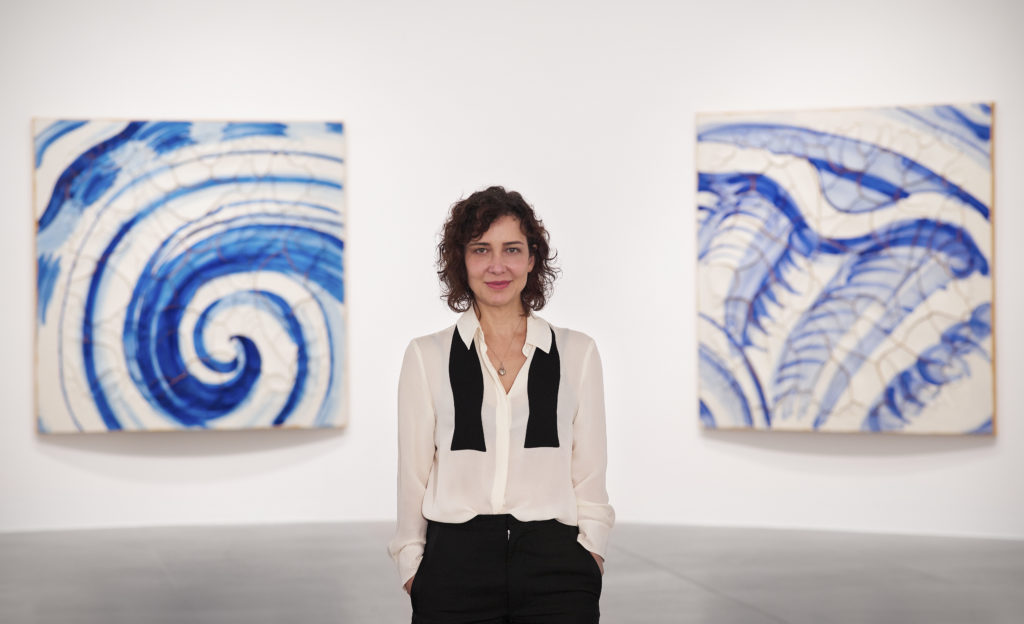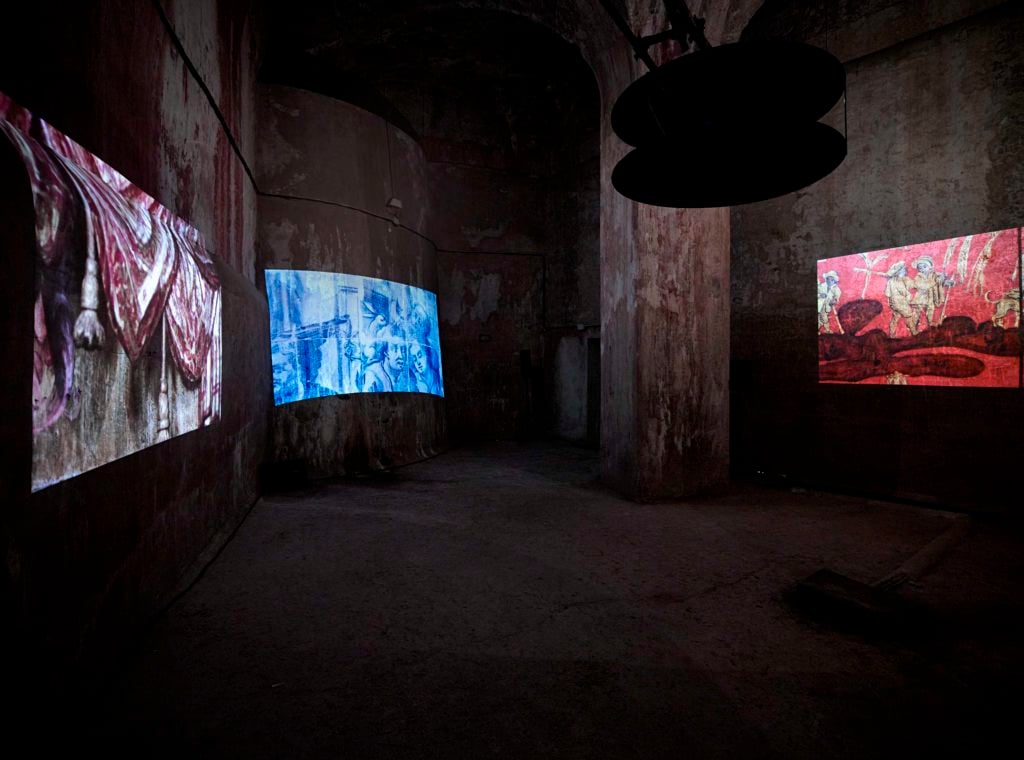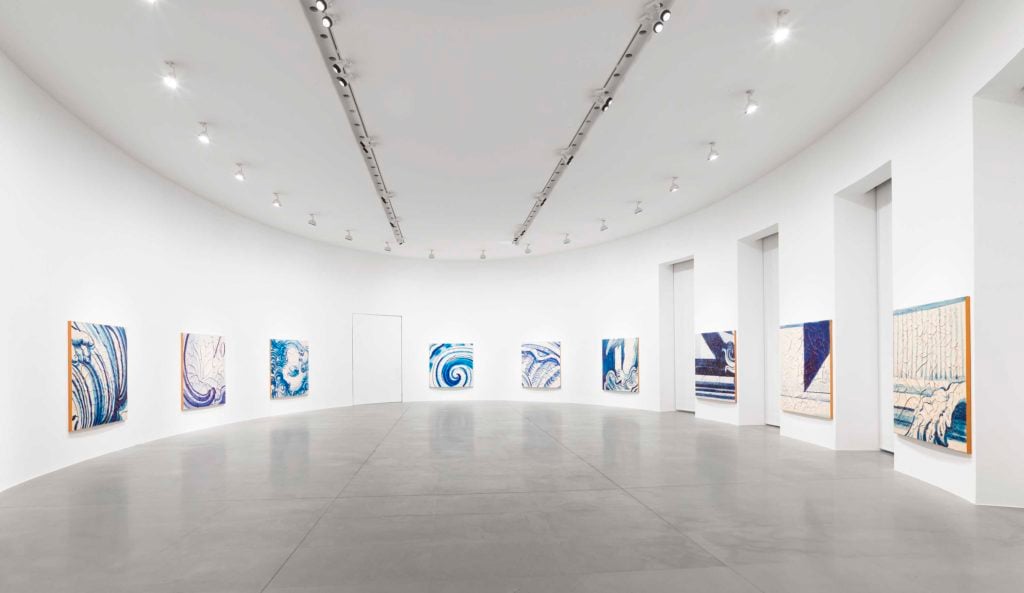On View
Adriana Varejão Brings Contemporary Baroque to Rome, Eternal City
The Brazilian artist is greeted with shows at Gagosian and Villa Medici.

The Brazilian artist is greeted with shows at Gagosian and Villa Medici.

Laura van Straaten

When in Rome? Go for baroque. That could be the punny M.O. of the revered Rio-based artist Adriana Varejão, who this week opened two exhibitions in the city where Bernini is a household name. To celebrate her first time exhibiting in Rome, the embassy of her native Brazil hosted a seated dinner for nearly 175 people in her honor.
Both exhibitions—“Adriana Varejão: Azulejão” at Gagosian Rome and Transbarroco at Villa Medici—are suffused with a complex historicity that’s characteristic both of the ancient metropolis itself and of Varejão, 51, whose career has long made use of what she calls “historic Baroque motifs, but all fragmented, re-ordered and turbulent.”
The genesis of both shows came when Louise Neri, a collaborator and close friend since 2001, and now a New York-based director at Gagosian, visited Varejão in Rio de Janeiro. “When I visited her in Rio two years ago, I saw Transbarroco exhibited,” recalled Neri, “[and] I immediately wanted to bring it to Rome.” The 2014 work, translated as “across the baroque,” is Varejão’s only multi-channel video installation to date.
Each of the four components comprises an unedited, 360-degree pan—either horizontal or vertical—of the dizzying interior of one of the four churches, described by Varejão as the “jewels of the mestizo Brazilian Baroque,” from the 17th and 18th centuries: the Church of San Francisco in Salvador, Bahia; the Third Order of Saint Francis in Rio de Janeiro; the Church of St Francis of Assisi in Ouro Preto; and the Cathedral of Mariana in Mariana, Minas Gerais. The accompanying soundscape is a collage of text, voices, sounds, and contrasting rhythms.

Adriana Varejão, Transbarroco (2014), four-channel video installation. Photo by: Matteo D’Eletto M3 Studio © French Academy in Rome–Villa Medici and the artist.
While Neri originally hoped “to show it in a Baroque chapel somewhere,” Pepi Marchetti Franchi, who directs Gagosian Rome, found it a home inside an old, odd-shaped cistern at Villa Medici, long the headquarters of the French Academy of Rome. The cistern’s bulbous walls, textured by centuries of wetness, added a distortive and damp quality to the video experience, which the artist said she found pleasing. On opening night, she was surrounded by friends from Brazil, who recognized the churches in the videos with an audible glee, despite the din. The videos were on view for only three days, part of a weekly initiative called “I giovedì della Villa—Questions d’art” organized by independent curator Pier Paolo Pancotto to showcase contemporary creativity—visual arts, cinema, music, theater, literature, and art history—in various forms.
A ten minute walk from Villa Medici, the exhibition at Gagosian’s white-walled, elliptical space on Via Francesco Crispi, comprises a baker’s dozen of Varejão’s largest-ever tile paintings, all made in 2016.
Neri, who likened Varejão’s importance in contemporary art to that of Yayoi Kusama or Agnes Martin, confirmed that nearly all of Varejão’s work on view at the gallery had already been acquired by the night of the opening. Varejão’s Wall With Incisions a la Fontana, which sold for $1.8 million at Christie’s in February 2011, is the auction record for a Brazilian artist.
The paintings at Gagosian are a departure for the artist, who for the first time has abstracted and greatly enlarged the motifs she has long used from Brazil’s traditional white and blue hand-painted azulejo tiles. Of one work on view, Azulejão (Angel), the artist noted that the angel depicted is so abstracted (as well as being upside down on the canvas, Baselitz-style) that an assistant worked on the canvas alongside her for three months before apprehending the cherubic shape.
What is not new is the process the artist used to make these pieces; it is one she has explored for years. First, she plasters canvas panels, and then allows them to form deep cracks. Next, she painstakingly paints fragments of tile from her digital inventory of more than 2500 images of Baroque tiles.
From steps away, the works look like enormous, ancient cracked tiles. “As is my way, they are totally simulated—not real tiles and not old,” she laughed as she gave a one-on-one walk-through the day before the exhibition opened to the public. The fissures in these works will surely recall (especially for Italians) the cracks or “cretti” of canvases by Alfredo Burri, although Varejão was unaware of his work when she began the series years ago.
The artist has employed such fakery in other forms for decades—including double and even triple trompe l’oeil techniques in some works—to investigate the “fake” way that civilizations use cultural traditions like decorative ceramics to conceal the violence of their very foundation—usually through colonization, something Rome knows a little bit about.
Terracotta azulejos conventionally bedeck ecclesiastical and secular architecture, especially the residences of the wealthy throughout Brazil. According to a curatorial statement, the tiles were part of “homogenizing the architecture into an illusionistic pictorial whole.” But azulejos have a complex provenance through trade and colonization, one that is connected with the ceramic traditions of the ancient Islamic world, China, Holland, Spain, and, most famously, Portugal. For Varejão, the tiles have long served as a metaphor for a mixing of cultures, by desire and more darkly by force. That mixing, or “mestizo” as the artist calls it, also denotes a person—like Varejão herself, a seventh generation Brazilian—of combined Amerindian, European and often African lineage.
The one sculpture on view at Gagosian is Rome Meat Ruin (2016), which boasts an even more obvious connection to the Baroque. From one angle the piece suggests—through a trompe l’oeil of oil on aluminum and polyurethane—a clean, gridded tiling of a health spa that has now come to ruin. From another angle, it is suddenly and horribly apparent that the artist has filled the walls with simulacra of bloody viscera.
That meat-like mess inside relates to an ongoing series, one with roots in the 1990s, that plays on both the misidentification of native-Brazilians with cannibals and the linked concept of “anthropophagy.” That concept stems from an important modernist manifesto by the Brazilian poet Oswald de Andrade, who argued that Brazilians “cannibalize” other cultures, especially Europe’s colonial cultures, in order to create something uniquely Brazilian. Anna Stothart, who curated Varejão’s first museum show in the U.S. at Boston’s Institute of Contemporary Art in late 2014, put it this way: “It’s about ingesting everything and regurgitating something entirely new as a form of empowerment against the colonizers.”

“Adriana Varejão: Azulejão,” Gagosian Gallery Rome. October—December 10, 2016. Photo by: Matteo D’Eletto M3 Studio. © Gagosian and the artist.
To plan the show at Gagosian, Neri and Varejão met in Italy for the artist’s first tour of Rome. “We visited key Baroque sites in Rome together, as well as our extraordinary elliptical gallery—itself an homage to Borromini,” Neri said. Varejão recalled that she was particularly inspired by the church of St. Ignatius of Loyola and the meat-like quality of the red marbled columns, as well as the trompe l’oiel effects throughout the church. “This concept of the deceptive surface is very much part of her vocabulary as an artist,” Neri explained.
Not even 900 yards from St. Ignacio, the Brazilian embassy on Piazza Navonna provided an appropriately baroque backdrop to the formal dinner in honor of Varejão; the embassy is housed in the Palazzo Pamphilj, which was completed in 1650 and remains to this day decorated with many frescoes by the greatest painters of that period. Among the global artists, collectors, curators, and museum directors in attendance: the director of Paris’s Fondation Cartier pour l’Art Contemporain, where Varejão also has work on view through January 8, 2007, in the group show, “The Great Animal Orchestra”; David Maupin of New York’s Lehmann Maupin, which represents Varejão in New York and which hosted a show of the artist’s work over the summer; Márcia Fortes of Galeria Fortes Vilaça, which represents the artist in São Paulo; and Victoria Miro, whose gallery represents the artist in London, and who will be exhibiting the artist’s work in late 2017.
“Adriana Varejão: Azulejão” is an exhibition at Gagosian Rome that runs from October 1 through December 10, 2016; Transbarroco runs at Villa Medici from September 29–October 2, 2016.